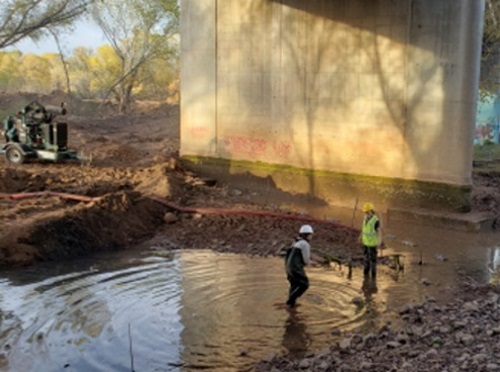The Arizona Department of Transportation recently illustrated in a blog post how ‘biomonitor’ teams from Northern Arizona University or NAU help the agency’s crews find and relocate endangered species – including snakes, birds, and fish – from construction sites.
[Above photo by the Arizona DOT]
Specifically, the biomonitor teams train construction workers and others involved in transportation projects to identify any endangered species and what to do if they come across one. The teams also monitor construction activity and help safely remove any endangered species out of harm’s way.
For example, for an Arizona DOT project to protect the I-17 Verde River Bridge footings – set to wrap up later this spring – agency crews built earthen bypass channels to contain river flow, allowing them to work outside of the river area safely. Simultaneously, the biomonitor team removed all fish from pools that required filling in, while also rescuing fish stranded during river relocation work.
Next, the biomonitor team identifies the endangered species it finds, photographing and measuring them, and then releases them back into the Verde River downstream from the construction area.
“The relocation distance varies, but it’s typically about 50 to 150 yards from the capture point,” noted Dr. Erika Nowak, an assistant research professor at NAU, who heads up the biomonitor team for the I-17 Verde River Bridge project.
“We don’t want to release the animals too far away, as moving them out of their home range can disrupt their behavior, cause them to become disoriented, and thus more likely to die,” she added.
This is one of several efforts by Arizona DOT to preserve both animals and plants considered endangered species.
The agency recently completed a bridge replacement project near Globe, AZ, which triggered the return of an endangered species of cactus transplanted and preserved by the agency during the project’s four-year timeline.
The U.S. 60 Pinto Creek Bridge is home to the endangered hedgehog cactus, which grows only within a several-mile radius of the site. About a foot high, usually covered in spines and often with red flowers at the top, the species is listed as endangered by the U.S. Fish and Wildlife Service and is protected under Arizona law. When the bridge replacement project began in 2018, a team comprised of biologists from the Arizona DOT and from the Desert Botanical Garden in Phoenix safely removed 34 cacti potentially affected by the construction work, then nurtured and propagated, replanting 61 total cacti in early March.

